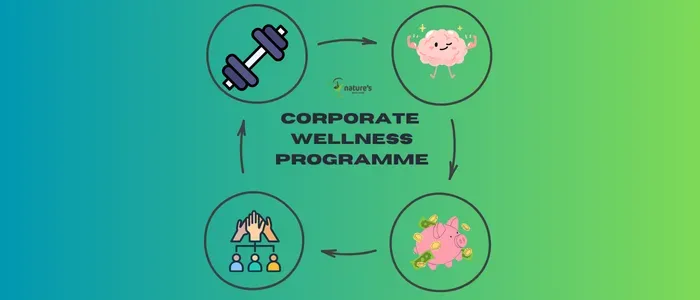What is a Workplace Wellness Programme?

What is a Workplace Wellness Programme?
A workplace wellness Programme is an organised initiative designed to enhance the physical, mental, and emotional health of employees. These Programmes aim to create a supportive work environment that promotes overall well-being, leading to increased productivity and employee satisfaction. By addressing various aspects of health, such as physical fitness, mental resilience, financial stability, and social connections, these Programmes contribute not only to individual employee welfare but also to the overall success of the organisation.
Understanding Workplace Wellness Programmes
Workplace wellness Programmes are more than just gym memberships or occasional health screenings. They encompass a holistic approach to improving employee health and well-being. According to Digital Adoption (2023), workplace wellness Programmes include a range of activities and initiatives aimed at fostering a healthier workforce [1]. These Programmes can be tailored to meet the specific needs of an organisation and its employees, ensuring that they are both effective and engaging.
The importance of these Programmes cannot be overstated. Healthy employees tend to incur lower healthcare costs and exhibit higher levels of engagement and productivity. Organisations that invest in wellness Programmes often see improvements in morale, reduced absenteeism, and enhanced retention rates. Furthermore, such initiatives foster a culture of care and support within the workplace, which can lead to a more committed workforce [5][7].

Importance of Workplace Wellness Programmes
In today's fast-paced corporate landscape, prioritising employee wellness is essential. The benefits of implementing comprehensive workplace wellness programmes extend beyond just the physical health of employees. A study published by PMC (2014) highlights that organisations with robust wellness Programmes report significant improvements in employee performance and job satisfaction [6].
Financial Benefits
Healthy employees are less likely to take sick days, resulting in reduced absenteeism. This, in turn, leads to increased productivity and lower healthcare costs for employers. According to Indeed (2023), companies that invest in employee wellness Programmes see a reduction in medical expenses and an improvement in overall business performance [3]. Additionally, healthy employees are more engaged and motivated, contributing positively to the company's bottom line.
Employee Satisfaction and Retention
Employee satisfaction and retention are critical factors for any organisation's success. Workplace wellness Programmes play a crucial role in enhancing employee satisfaction by creating a supportive and caring environment. Hibob (2023) notes that companies with strong wellness programmes experience higher retention rates and a more committed workforce [7]. When employees feel valued and supported, they are more likely to stay with the company, reducing turnover and associated costs.
Cultural Impact
Wellness Programmes foster a culture of care and support within the workplace. Employees who feel supported are more likely to be engaged and committed to their work. Thoughtful (2023) emphasises the importance of building a positive organisational culture through wellness initiatives [8]. A culture that values employee well-being contributes to a more harmonious and productive work environment.
Current Corporate Initiatives
Many organisations have recognised the value of workplace wellness Programmes and have implemented various initiatives to promote employee health and well-being. These initiatives cover different aspects of health, including physical, mental, financial, and social well-being.
Physical Wellness Programmes
Physical wellness Programmes focus on promoting regular exercise, proper nutrition, and overall physical health. Here are some common initiatives:
- On-site fitness centers or gym reimbursements: Encouraging regular exercise is a key component of physical wellness. Companies like Google and Apple offer on-site fitness centers where employees can work out during their breaks. Alternatively, some organisations provide gym reimbursements to encourage employees to maintain their fitness routines outside of work [1].
- Standing desks and ergonomic equipment : Ergonomic furniture, such as standing desks and adjustable chairs, helps promote better posture and reduces strain on the body. Studies have shown that using standing desks can improve posture and reduce the risk of musculoskeletal disorders [6].
- Fitness challenges : Engaging employees in friendly competitions can motivate them to stay active. Fitness challenges, such as step-counting contests or team-based sports activities, encourage employees to incorporate physical activity into their daily routines [4].
- Health screenings and vaccinations : Regular health screenings and vaccinations help identify potential health risks early. Many organisations offer annual health check-ups and flu vaccinations to keep their employees healthy [2].
- Sports teams and activity clubs : Combining physical activity with social interaction can enhance employee well-being. Sports teams and activity clubs provide opportunities for employees to engage in physical activities while building camaraderie and teamwork [1].
Mental Health Initiatives
Mental health is equally important as physical health, and many organisations have started focusing on mental wellness Programmes. Here are some initiatives:
- Employee Assistance Programmes (EAP) : EAPs provide confidential counseling services to employees dealing with personal or work-related issues. These Programmes offer professional support and guidance, helping employees manage stress and maintain mental well-being [7].
- Meditation and mindfulness app subscriptions : Mindfulness practices, such as meditation, have been shown to reduce stress and improve focus. Many organisations offer subscriptions to meditation apps, encouraging employees to practice mindfulness regularly [5].
- Stress management workshops : Stress is a common issue in the workplace, and managing it effectively is crucial for maintaining mental health. Stress management workshops teach techniques for handling workplace pressures, such as time management and relaxation exercises [6].
- Mental health days : Allowing employees to take time off for mental health reasons can help them recharge and return to work refreshed. Mental health days are becoming increasingly popular as organisations recognise the importance of mental well-being [3].
- Flexible working arrangements : Supporting work-life balance is essential for maintaining mental health. Flexible working hours and remote work options enable employees to manage their personal and professional responsibilities more effectively [2].
Financial Wellness
Financial wellness Programmes aim to empower employees to manage their finances effectively. Here are some initiatives:
- Financial planning sessions : Guiding employees in managing their finances is a key aspect of financial wellness. Financial planning sessions provide employees with the tools and knowledge needed to make informed financial decisions [4].
- Retirement planning assistance : Preparing for retirement is an important consideration for many employees. Retirement planning assistance helps employees plan for their future financial needs, ensuring they have a secure retirement [3].
- Student loan repayment Programmes : Student debt can be a significant burden for many employees. Student loan repayment Programmes help alleviate this burden by providing financial assistance for repaying student loans [1].
- Investment education workshops : Empowering employees to make informed investment decisions is crucial for long-term financial well-being. Investment education workshops provide employees with the knowledge and skills needed to make sound investment choices [2].

Work-Life Balance
Achieving a good work-life balance is essential for maintaining overall well-being. Here are some initiatives:
- Flexible working hours and remote work options : Offering flexible working hours and remote work options enhances job satisfaction by allowing employees to manage their personal and professional responsibilities more effectively [5].
- Paid parental leave : Supporting new parents during critical life transitions is important for maintaining work-life balance. Paid parental leave provides employees with the time they need to care for their newborns without sacrificing their careers [3].
- Sabbatical Programmes : Sabbaticals allow employees to take time off for personal growth or education. These Programmes provide employees with the opportunity to recharge and return to work with renewed energy and motivation [1].
- Compressed work weeks : Compressed work weeks provide extra personal time without sacrificing productivity. Employees can complete their work in fewer days, giving them more time for personal activities [2].
Social Connection
Building strong social connections is essential for maintaining mental and emotional well-being. Here are some initiatives:
- Team-building activities : Strengthening relationships among employees is crucial for fostering a positive work environment. Team-building activities, such as group projects and social events, help build camaraderie and teamwork [4].
- Employee resource groups : Celebrating diversity and fostering belonging are important for creating an inclusive workplace. Employee resource groups provide a platform for employees to connect with others who share similar interests or backgrounds [3].
- Social events and celebrations : Building morale through shared experiences is an effective way to strengthen social connections. Social events and celebrations, such as holiday parties and team outings, provide opportunities for employees to bond and have fun together [2].
- Volunteer opportunities : Encouraging community engagement is an important aspect of social connection. Volunteer opportunities allow employees to give back to their communities while building meaningful relationships with colleagues [1].
Example of a Comprehensive Wellness Plan
A successful workplace wellness Programme should be well-rounded and engaging throughout the year. Here’s an example outline for a 12-month Programme:
Workplace Wellness Program Activities
| Quarter | Focus Area | Activities 1 | Activities 2 |
|---|---|---|---|
| Q1 | Physical Health | Health screenings | Cardio classes |
| Q2 | Mental Wellness | Stress management workshops | Mental health discussions |
| Q3 | Financial Wellness | Financial planning workshops | Budgeting challenges |
| Q4 | Social & Environmental Wellness | Team challenges | Community service projects |
Q1: Physical Health
The first quarter focuses on physical health, with activities such as health screenings, cardio classes, and nutrition workshops. Health screenings help identify potential health risks early, enabling employees to take preventive measures. Cardio classes and nutrition workshops promote healthy eating habits and regular exercise, contributing to overall physical well-being [2].
Q2: Mental Wellness
The second quarter focuses on mental wellness, with activities such as stress management workshops and mental health discussions. Stress management workshops teach employees techniques for handling workplace pressures, while mental health discussions provide a platform for open conversations about mental health issues. These activities help employees manage stress and maintain mental well-being [6].
Q3: Financial Wellness
The third quarter focuses on financial wellness, with activities such as financial planning workshops and budgeting challenges. Financial planning workshops provide employees with the tools and knowledge needed to make informed financial decisions, while budgeting challenges encourage employees to manage their finances effectively. These activities empower employees to achieve financial stability and security [4].
Q4: Social & Environmental Wellness
The fourth quarter focuses on social and environmental wellness, with activities such as team challenges and community service projects. Team challenges promote collaboration and teamwork, while community service projects encourage employees to give back to their communities. These activities help build strong social connections and foster a sense of belonging [1].
Best Practices for Successful Programmes
To ensure the effectiveness of workplace wellness Programmes, organisations should consider the following best practices:
Leadership Engagement
Active participation from leaders demonstrates commitment to wellness initiatives. When leaders actively participate in wellness Programmes, they set an example for employees and show that the organisation values employee well-being [2].
Data-Driven Approach
Regular assessments refine offerings based on employee needs and Programme outcomes. Collecting data on employee health and wellness enables organisations to tailor their Programmes to meet the specific needs of their workforce. This data-driven approach ensures that wellness Programmes are effective and relevant [6].
Communication Strategy
Utilise various channels to promote Programmes and share success stories. Effective communication is essential for engaging employees in wellness programs. Using multiple channels, such as email newsletters, social media, and intranet platforms, helps reach a wider audience and keeps employees informed about Programme updates and successes [3].
Incentive Structure
Implement rewards for participation to encourage engagement. Offering incentives, such as gift cards, paid time off, or recognition awards, motivates employees to participate in wellness Programmes. These rewards acknowledge employees' efforts and encourage continued engagement [4].
Accessibility and Privacy
Ensure Programmes are accessible while maintaining confidentiality to build trust. Accessibility is crucial for ensuring that all employees can participate in wellness Programmes. Providing accommodations for employees with disabilities and offering flexible scheduling options ensures that everyone has the opportunity to engage. Maintaining confidentiality builds trust and encourages employees to participate openly [7].
Continuous Improvement
Adapt Programmes based on feedback and emerging trends to remain relevant. Continuously improving wellness Programmes ensures that they remain effective and engaging. Gathering feedback from employees and staying up-to-date with emerging trends in wellness enables organisations to refine their Programmes and address evolving needs [8].
Conclusion
Implementing a thoughtful workplace wellness Programme invests in both employees' futures and the organisation's success. By addressing various dimensions of well-being—physical, mental, financial, and social—companies can cultivate a healthier, happier, and more productive workforce. Emphasising employee wellness not only benefits individuals but also contributes significantly to organisational performance and culture.
Citations:
[1] https://www.digital-adoption.com/workplace-wellness/
[2] https://nailted.com/blog/how-to-create-an-employee-wellness-Programmeme/
[3] https://www.indeed.com/career-advice/career-development/benefits-of-wellness
[4] https://woliba.io/blog/workplace-wellness-challenges/
[5] https://www.percihealth.com/articles/benefits-of-employee-health-wellness-Programmememes
[6] https://pmc.ncbi.nlm.nih.gov/articles/PMC3937880/
[7] https://www.hibob.com/hr-glossary/employee-wellness-Programmeme/
[8] https://www.thoughtfull.world/resources/blog/understanding-employee-wellness-Programmememe
FAQs
Q: What is a workplace wellness programme?
A: A workplace wellness programme is an initiative designed to enhance the physical, mental, and emotional health of employees, leading to increased productivity and satisfaction.
Q: How do workplace wellness programmes benefit employers?
A: Employers benefit from reduced healthcare costs, higher employee engagement, lower absenteeism, and improved retention rates.
Q: What types of activities are included in a workplace wellness programme?
A: Activities can range from on-site fitness centers and health screenings to stress management workshops, financial planning sessions, and team-building events.
Q: Can small businesses implement effective workplace wellness programmes?
A: Yes, small businesses can create tailored wellness programmes that fit their budget and needs, focusing on key areas like physical activity, mental health, and work-life balance.
Q: How often should a workplace wellness programme be updated?
A: Programmes should be reviewed and updated regularly based on employee feedback, emerging trends, and data-driven insights to remain relevant and effective.
Take the First Step Towards a Healthier Workplace with Nature's Pure Love!
Are you ready to transform your workplace into a hub of health and productivity? At Nature's Pure Love, we specialise in creating bespoke holistic wellness plans tailored to your organisation's unique needs. From our innovative C.R.E.A.M. model to our range of natural supplements and expert guidance, we provide everything you need to support your employees' well-being.
Start today by scheduling a personalised consultation with one of our holistic health specialists. Let us help you build a healthier, happier, and more productive workforce.
Contact Us Now to Learn More About Our Workplace Wellness Solutions!
Book Your Consultation Today | Explore Our Services
By investing in your employees' health, you're investing in the future success of your business. Join us at Nature's Pure Love and make a positive change that lasts!











